 National Radio Astronomy Observatory
National Radio Astronomy ObservatoryResearch Projects by NRAO Site
 National Radio Astronomy Observatory
National Radio Astronomy Observatory

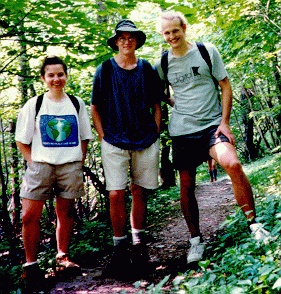
Charlottesville REU96 summer students foraging. Left to right: Brian Wang, John Armstrong, Julianne Zuber (GB), Daniel Larson, Eric Schulman (mentor), Mary Putman, Jennifer Wiseman (mentor), Matthew Weatherly (GB) and Gregory Holsclaw (GB).

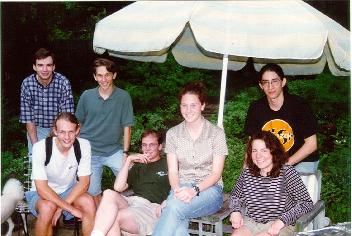
Many of the students in the NRAO-Green Bank program visited Charlottesville for a tour of the Central Development Laboratory , and of the University of Virginia's facility for the fabrication of the Semiconductor-Insulator-Semiconductor detectors used in millimeter wave receivers, the Semiconductor Device Laboratory.
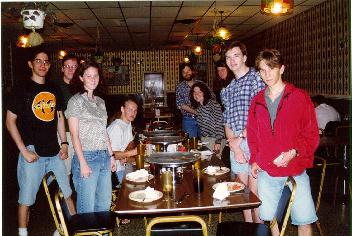
The students had an informal get-together with astronomers from the University of Virginia at lunch, and from NRAO in the evening, followed by a visit with graduate students from the University's Astronomy Department.
In August, the Charlottesville students visited Green Bank to see the NRAO telescopes located there, to meet members of the Green Bank staff, and to attend the annual picnic.
The students gave a series of 15 minute talks on their projects during a lunch symposium in Charlottesville before they began leaving for the summer. They produced short reports describing their summer research.
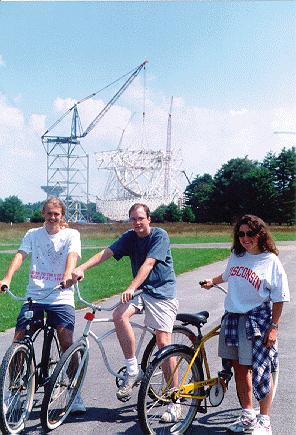
The students traveled to Green Bank for a session of observations on the 43m telescope. This involved observations of OH emission from C/1995 O1 Hale-Bopp, peaking in intensity near this time.
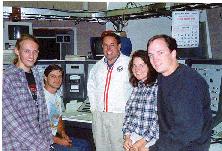
| Date | Person | Item | Location | Time |
| 19 Jun | Wootten | Orientation | Rm 317 ER | 0900 |
| 19 Jun | Weatherly | Visit of Green Bank Summer Students | Alden House | pm |
| 20 Jun | Bradley | Central Development Lab Introduction | Rm 228 Ivy Road | 9am |
| 20 Jun | Bradley | Tour of Central Development Lab | Rm 228 Ivy Road | 10 am |
| 20 Jun | Wootten | Pizza Lunch at Anna's No. 5 | 115 Maury Ave 977-6228 | 12 noon |
| 20 Jun | Bradley | Tour of U. Va. Device Fabrication Facility | U. Va. | 1:30 pm - 3:30 pm |
| 20 Jun | Wootten | BBQ in the Wootten's backyard, | 1714 Solomon Rd. Ch'ville 971-6518 | 6pm - 8 pm |
| 21 Jun | Uson | Radiotelescopes and Interferometry | Rm 317, | 9am |
| 21 Jun | open | Public Night at McCormick Observatory | at the Observatory | 9pm |
| 24 Jun | open | Open | ... | ... |
| 26 Jun | Condon | Radio Sources | Rm 317, | 9am |
| 28 Jun | Nice | Pulsars | Rm 317, | *9am* |
| 1 Jul | Bridle | Jets, Radio Galaxies and Quasars | Rm 317, | 9am |
| 3 Jul | D. Hogg | The Interstellar Medium in Galaxies | Rm 317, | 9am |
| 5 Jul | open | Public Night at McCormick Observatory | at the Observatory | 9pm |
| 8 Jul | Zensus | The VLBA: Nuclear Jets and Compact Structures | Rm 317, | 9am |
| 10 Jul | Turner | Interstellar Molecules and Their Chemistry | Rm 317, | 10am |
| 11 Jul | Rood | Helium-3, | University of Virginia | TBA |
| 15 Jul | Simon | Extrasolar Planets and the Millimeter Array | Rm 317, | 9am |
| 17 Jul | Desai | Radiowave Scattering | Rm 317, | 9am |
| 19 Jul | Barnbaum | Evolved Stars | Rm 317, | 9am |
| 19 Jul | open | Public Night at McCormick Observatory | at the Observatory | 9pm |
| 22 Jul | Uson | Cosmology | Rm 317, | 9am |
| 24 Jul | Schulman | X-Ray Astronomy | Rm 317, | 9am |
| 26 Jul | Uson | To Be Announced | Rm 317, | 9am |
| 31 Jul | Wootten | Comets | Rm 317, | 9am |
| 2 Aug | Wiseman | Molecular Clouds | Rm 317, | 9am |
| 2 Aug | open | Public Night at McCormick Observatory | at the Observatory | 9pm |
| 3 Aug | Wiseman | Travel to Green Bank for Observatory picnic, tours, etc. | ... | ... |
| 3 Aug | Wiseman | CV students overnight Green Bank | GB | ... |
| 3 Aug | Wiseman | GB Picnic | GB | ... |
| 4 Aug | Wiseman | Return from Green Bank after lunch. | GB | ... |
| 6 Aug | Wootten | Summer students present their research (lunch) | Rm 317 | 12:05 |
| 13 Aug | Wootten | Travel to Green Bank for Observations of OH in C/Hale Bopp | 43m | 8am |
| 13 Aug | Wootten | Overnight GB. | Dorms | am |
| 14 Aug | Wootten | Submit OH paper, tour site, return to CV. | GB | pm |
| 16 Aug | open | Public Night at McCormick Observatory | at the Observatory | 9pm |

Daniel Larson worked with Eric Schulman in analyzing the variability of X-ray sources in M33, using data from the ROSAT and ASCA satellites. In particular, he will precisely determine the period of an eclipsing binary X-ray source in M33 and attempt to determine whether its orbital period is changing. A paper, `A Revised Orbital Period for M33 X-7' by Larson and Schulman, will appear in the February 1997 issue of The Astronomical Journal.

Radio emission near 94 MHz from C60 molecules, or `Bucky Balls', might be detected in the interstellar medium with a sensitive telescope such as the NRAO 140' telescope in Green Bank. However, local FM radio interferes at or near the frequency of emission, obscuring the incredibly weak interstellar signal. Bryan worked with Richard to design a receiver capable of cancelling the undesired radio interference, using an adaptive Least-Mean-Squared cancellation algorithm.

We are conducting the survey using the VLBA at 2cm to investigate the properties of compact extragalactic radio sources. The survey is aimed at morphological source classification, the physics of parsec-scale jet sources, and determination of parameters used in cosmology. The summer project will include the complete analysis of a 2 day observing run in April. This involves data calibration, image analysis, classification, and search for superluminal motion. The results will be compared to 4 runs we have had in 1994/1995. The summer project will be a good opportunity for John to learn about VLBI, and to get a detailed training on VLBA data analysis. His experience with AIPS will be useful and give him a head start towards working on interesting aspects of the project. Besides the work on the data, we plan to involve John in literature research to collect information about the survey sources. Finally, we are also planning to make part of the project results available on the World-Wide Web, which he will be involved in as well.

She and Jennifer studied high velocity molecular gas outflows from young stellar objects in the Orion Molecular Cloud, using data from the VLA.

An image of the carbon monoxide distribution in C/1996 B2 (Hyakutake) taken by Jeff Mangum with the NRAO 12m radiotelescope will be analyzed. The primary goal of the project is to determine whether the azimuthally averaged image shows evidence for a second source of CO located within the coma. Such a second source, arising from photodissociation of more complex molecules, has been hypothesized. A measurement of its location could offer clues to the identity of the parent molecule. Will was not employed by the REU program.



Here are the NRAO/Socorro 1996 REU summer students (+ Anuj), visiting the VLA
on the plains of San Augustin:


1 - Lauren Herold ,
2 - Craig Heinke ,
3 - Olivia Johnson ,
4 - Todd Konkel ,
5 - Lon Freeman ,
6 - Gus Tucker ,
7 - Pat Udomprasert ,
8 - Andrew Kerr ,
9 - Anuj Sarma (non-REU summer student)

The summer REU program at NRAO/Socorro in 1996 consisted of 4 main categories
of activity:
1 - student research projects, in collaboration with an
NRAO advisor
2 - lectures to the students by NRAO staff members
3 - a joint student project, involving observations with the
Very Large Array (VLA)
4 - guided tours of the VLA, given by the students on weekends
The 1996 REU program at NRAO/Socorro is under the direction of
Bryan Butler , assisted by
Min Yun , both of whom are
Jansky Postdoctoral Researchers
at NRAO/Socorro.

Student Research Projects
Each of the REU students worked with one or more advisors on one or more
projects throughout the summer. This was the main focus of the program, and
the majority of the students' time was spent on these research endeavors.
These projects involved observing, data reduction and analysis, equipment
development, and theoretical studies. At the end of the program, each student
gave a lunch talk explaining the main project(s) he or she worked on during
the summer. The possibility exists for the students to present their original
research at scientific meetings deemed appropriate by their advisor(s).
Following is a detailed list of the specific projects carried out by the
NRAO/Socorro REU students:
For a full description of Olivia's project,
click here .
For a full description of Andrew's project,
click here .
For a full description of Lauren's project,
click here .
For a full description of Todd's project,
click here .
For a full description of Craig's project,
click here .
For a full description of Pat's project,
click here .
For a full description of Gus' project,
click here .

Lectures, etc...
Several lectures about radio astronomy and interferometry were presented,
allowing the students to obtain a good understanding of the technique. Talks
were also given on general topics in astronomy, presented by members of the
scientific staff. The astronomy talks were designed to give the students an
understanding of what sort of research goes on at NRAO, and in radio astronomy
in general. The detailed list of lectures and events for the summer is in the
following table.
| Date | Time | Location | Item |
|---|---|---|---|
| 6/11 | 1400 | CON3 | Discussion of this list - Min Yun |
| 6/12 | 1400 | CON1 | Safety Lecture - Jon Spargo |
| 6/13 | 0930 | CON3 | Telescopes - Peter Napier |
| 6/17 | 1400 | CON3 | Fourier Transforms - Bryan Butler |
| 6/19 | 1400 | CON3 | Basic Interferometry - Tony Beasley |
| 6/20 | 0930 | AUD | PR for the VLA - Dave Finley |
| 6/20 | 1100 | Lobby | Leave for VLA site/Datil |
| 6/20 | 1230 | Datil | Lunch at Eagle Guest Ranch |
| 6/20 | 1400 | Site | Guided Tour of VLA - Dave Finley |
| 6/21 | 1300 | CON3 | Imaging/Deconvolution - Tim Cornwell |
| 6/22 | 1030 | Site | Tours of VLA - summer students |
| 6/23 | 1030 | Site | Tours of VLA - summer students |
| 6/24 | 1400 | AUD | VLBI - Craig Walker |
| 6/26 | 1400 | AUD | VLA Observations (1) - Bryan Butler |
| 6/28 | 1400 | AUD | VLA Observations (2) - Bryan Butler |
| 6/29 | 1030 | Site | Tours of VLA - summer students |
| 6/30 | 1030 | Site | Tours of VLA - summer students |
| 7/01 | 1400 | CON3 | Radiative Transfer & Continuum Emission Processes - Bryan Butler |
| 7/03 | 1400 | CON3 | Spectral Lines - Min Yun |
| 7/06 | 0900 | Site | Tours of VLA - summer students |
| 7/07 | 0900 | Site | Tours of VLA - summer students |
| 7/08 | 0500 | Site | Observing Time |
| 7/08 | 1700 | Site | Observing Time |
| 7/09-7/11 | Tucson Trip | ||
| 7/13 | 0900 | Site | Tours of VLA - summer students |
| 7/14 | 0900 | Site | Tours of VLA - summer students |
| 7/16 | 1400 | AUD | Planets & Sun - Bryan Butler & Tim Bastian |
| 7/18 | 1300 | CON3 | Radio Stars, SN/SNR, masers - Michael Rupen |
| 7/20 | 0900 | Site | Tours of VLA - summer students |
| 7/21 | 0900 | Site | Tours of VLA - summer students |
| 7/22 | 1430 | CON3 | Milky Way - Mark Claussen |
| 7/24 | 1400 | CON3 | Other Galaxies (HI) - Dave Westpfahl |
| 7/27 | 0900 | Site | Tours of VLA - summer students |
| 7/28 | 0900 | Site | Tours of VLA - summer students |
| 8/01 | 1200 | AUD | lunch talks - Olivia Johnson & Lon Freeman |
| 8/03 | 0900 | Site | Tours of VLA - summer students |
| 8/04 | 0900 | Site | Tours of VLA - summer students |
| 8/06 | 1400 | CON3 | Radio Galaxies - Greg Taylor |
| 8/08 | 1300 | CON3 | High-z Objects - Chris Carilli |
| 8/10 | 0900 | Site | Tours of VLA - summer students |
| 8/11 | 0900 | Site | Tours of VLA - summer students |
| 8/13 | 1200 | AUD | lunch talks - Todd Konkel, Lauren Herold & Andrew Kerr |
| 8/15 | 1200 | AUD | lunch talks - Pat Udomprasert, Craig Heinke & Gus Tucker |
| AUD = Auditorium | |||
| CON3 = 3rd Floor Conference Room | |||
| CON1 = 1st Floor Conference Room | |||

Joint Student Research Project
The students were given 2 hours of their own VLA time, which they used to
observe a very high redshift galaxy (z=4.7) at 2-cm, and NGC253 at 1.3 and
0.7-cm.


Students conducting their research at the NRAO Green Bank Site in West Virginia included . The program at Green Bank is under the direction of Dr. Ron Maddalena.

(1) Single-Board Control and Reset Box
For his first project, he designed a "Single-Board Control and Reset Box" that allows an engineer or telescope operator to connect to the console port of a single-board embedded controller, and perform a hardware reset of the board. This box is capable of handling up to 15 embedded computers at a time. There will be 4 of these boxes built for the GBT, and installed in the Receiver room, the Active Surface Room, the Alidade Servo Room, and in the Equipment Room.
The box consists of a terminal server for connecting it to the network, a digital I/O interface for handling the reset bits, and 15 serial interface ports to the various embedded computers. THe whole thing is built into an EMI/RFI shielded rack-mountable enclosure. Matthew built a prototype, and wrote software to control it. The results of his efforts are available on the Web by clicking here . We are releasing the production version for 4 copies later this month.
(2) SIB Reliability enhancement
He then designed and tested a reliability enhancement for the VLBA Standard Interface Board that we are using in most of the GBT systems for communication with the telescope control system. The modification consisted of designing a PC board and picking out components for a power supply monitor and watchdog timer to be retrofitted to the existing design. He built a breadboard prototype of the PC board he designed, and figured out the necessary firmware changes to be made the the VLBA firmware, and tested thes in our lab. We have a package ready to be released for production if the decision is made to do it. This project's design is also available via WWW by clicking here .
(3) GBT Alidade Room Monitor & Control Equipment Rack design
For his 3rd project, Matthew gathered data and laid out the equipment
racks for the Alidade room, figured out the interconnections between
devices in the racks, and made tables showing these interconnections.
These racks will be assembled later this winter and will be eventually
installed in the GBT.


Greg was to learn all he could about the computer interface hardware
for the forty foot, the computer control software for the forty foot telescope
and the work done by a former summer student to improve these systems, then to
build on those improvements - The ultimate outcome is to have a reliable
computercontrol system for the forty foot telescope; one that is easier for the
observer to use.
Greg first learned the basics about radio
astronomy instrumentation by using the forty foot. Since there were
discrepencies between computer controlled pointing of the telescope and manual
pointing of the telescope, Greg was asked to create and conduct pointing
experiements with the forty foot telescope.
He also improved the motor control hardware. For years we have been blowing
relays in the circuit due to power surges when you change the direction in which
the telescope is moving.
Greg made some changes to the computer interface hardware and worked with the
software that had been partially developed by a former summer student. He also
analysed the system as it currently stands and made an instructive report about
what needs to be done. He documented previously undocumented hardware and
software.



Students conducting their research at the NRAO Tucson Site in Arizona included . The program in Tucson is under the direction of Jeff Hagen. As the NRAO offices are across the street from KPNO/NOAO offices, the REU group shares in the activities of the NOAO REU program there.


Ms. Branch will work on coupling OTF data to the PVWave visualization package. In particular, she will build program interfaces to three dimensional data images taken in the `on-the-fly' mode with the 12m, in FITS format and, possibly, AIPS image files. This work will partially build upon the work done by Phil's student of last summer Jim Wren REU95 .
Based on the growing popularity of On The Fly (OTF) observing with the NRAO 12m telescope on Kitt Peak, the astronomical community needed a way to view OTF data more dynamically than with the current two dimensional standards such as AIPS and aipsview. Because the data obtained by OTF observing is four dimensional (i. e. \ right ascension, declination, velocity, and intensity), it makes sense to actually observe these images four dimensionally in velocity-space. To fill this void, Clair Branch (University of Michigan) wrote an interface between OTF data in the FITS format and PV-Wave. As a practical test case for this visualization package, OTF images of the CO emission from a remarkable molecular cloud near the Pleiades star cluster were analyzed. The molecular cloud ``visitor'' near the Pleiades star cluster presents a unique case of cluster-cloud interaction in the interstellar medium. The cometary structure of this cloud is due to the apparent interaction between the Pleiades and a molecular cloud which has been injected into the region. Since most star-cloud interactions involve HII regions or supernova remnants, the proximity (about 135 pc) and unusual nature of the Pleiades cluster-cloud interaction represents a unique environment in which to study the detailed structure within this phenomenon. Using OTF measurements of the CO J=2-1 emission toward this region, the visualization software developed by Clair Branch allowed us to study the physical conditions and dynamics of this interaction region.

